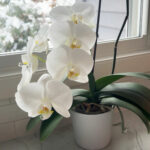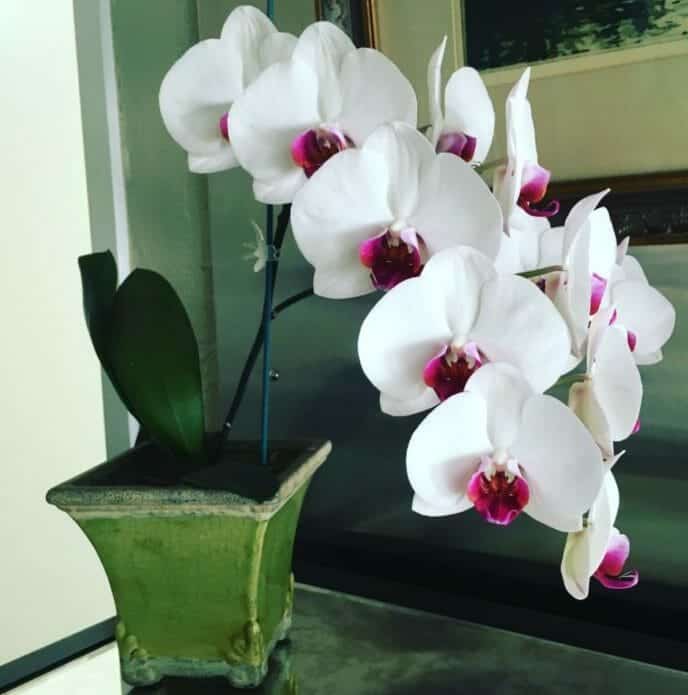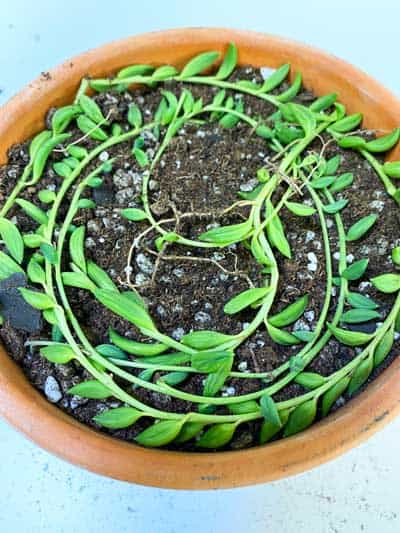Some of the links in this post may be affiliate links.
If you’re looking for a simple, down to earth, practical guide on how to grow orchids under lights, this is it. I know that all the technical stuff concerning grow lights can be overwhelming, confusing, and enough to make you not even want to try. This guide will change that and make it not only easy, but enjoyable.

I have a few recommendations for grow lights, or if you already have your own, I’ll give you some criteria that you can use so that you can be confident in your set-up and choices.
Whether you are going to use grow lights to supplement natural light, or even just strictly grow your orchids (and other plants) under only grow lights, this guide will help.
Table of Contents
How to Grow Orchids Under Grow Lights
Here are all the important aspects of grow lights, with several tips for your set up to make things easy. I will also show some specific grow lights and explain the different types of setups that you can use and how to quantify if you have enough light for your orchids to grow and bloom.
No more guesswork!
Choosing a Grow Light
For orchids (whether you are growing Phalaenopsis or any other types) I recommend using full spectrum LED grow lights that are around 4000K color temperature. Depending on the time of day and other factors, natural sunlight can be anywhere from approximatley 2000K to 6500K, but it can even go higher.
The lower the color temperature, the more red there is in the light. If you recall, white light is made up of all the colors of the rainbow. Remember back to elementary school if you’ve played with prisms before. If you pass white light through a prism, you see all the colors of the rainbow.
Red light is more conducive to flowering (lower color temperature), and blue (higher color temperature) is better for vegetative growth but both are important. A full spectrum grow light with a color temperature of 4000K is a good balance between the two and provides great results for orchids.
Can you use other temperatures of grow lights? Sure, but this has worked really well in my experience for orchids.

At this point, I want to mention a trend that I’ve been seeing everywhere…those ugly purple lights. Although they’re good for the plants, these lights are only using the red and blue wavelengths of the visible light spectrum (hence why the lights are purple). These are good for the plants, but personally I think that they are REALLY ugly to look at.
Why do this? Just stick with a white, full spectrum LED grow light so that you can also enjoy your orchids and view your plants nicely. There is absolutely no reason to use purple grow lights!
I’ve compiled a list of grow lights in my Amazon shop for LED grow lights and accessories. It has several great grow lights, and some other accessories.
Measuring Your Grow Lights
For Phalaenopsis orchids, many sources including the American Orchid Society, recommend 1000 foot candles of light for good growth. This is a great point to shoot for, but you can grow (and flower!) Phalaenopsis orchids with less and I’m speaking from personal experience.
When using grow lights, I recommend at least 600-700 foot candles of light (measured at the level of the leaves). So whatever grow light you are using (as long as it’s a white grow light and not the funky purple ones), you can use this guideline. The closer the plant is to the light, the higher the foot candles, so keep that in mind when you measure.
I use a simple, inexpensive light meter below, and you can buy this Dr. Meter LX1330B from Amazon.

Grow Light Timers
I like to make things easy, because if I don’t, chances are it will frustrate me. So for any of my grow light setups, I like to plug them into a timer.
I recommend leaving the grow lights on for 12-14 hours daily for best results. I really love the power strip with timer I’m showing in the photo below. It is a surge protector that has a built-in timer and has 4 outlets for “always on” and another 4 outlets that you can use for the timer. It really makes things easy and flexible.

Types of Grow Light Set-Ups
The beauty of grow lights is that you can use so many different setups. You can replace individual light bulbs in any of your light fixtures with grow light bulbs. You can have tripod-style grow lights, lights to place on a desktop, light fixtures or shop lights to hang from the ceiling, and even long, narrow shop lights that you can add onto wire storage racks to make a larger light stand.
This flexibility really makes it super easy! Before I show some examples, remember that you can use any full spectrum, white, LED grow light for Phalaenopsis orchids as long as you have at least 600-700 foot candles of light, and keep the lights on for 12-14 hours a day year-round.
Here is a setup that I created that I’ve had for over a year now, mostly with water culture orchids and they blew it out of the park with flowering and growth. I prefer growing Phals in an actual medium, but it is fun to experiment. This setup below used a single grow light, a 4000K 65W LED grow light from Horticultural Lighting Group.

This is a pretty powerful one and with a single unit, you can illuminate a pretty large area. I have this one on the top shelf of the plant stand in the photo above, but you can also hand it from a ceiling and illuminate a broader area.
Here is a newer setup, yet to be filled with plants, but these Barrina light strips are incredible and very flexible. For this type, you can connect up to 8 lights in sequence. The lights are 20W each and I placed 3 lights on each of the top two shelves, and I was left with 2 so I only added two lights in the bottom shelf.
For orchids, I recommend 3 of these lights per shelf if your shelves are 18 inches deep. If you have 2 foot deep shelves, I’d use 4 per shelf.

The grow light set comes with 8 of these 4 foot long lights (they also come in shorter if you need that), and I simply zip tied the lights to the wire shelf as shown in the photo below.

These Barrina LED shop lights are inexpensive and excellent for orchids. I know an orchid grower who uses this exact same setup for all of her orchids and grows hundreds in her basement, exclusively under these grow lights, including many orchids that need more light than Phalaenopsis typically. It will work for quite a wide range of orchids and plants.
Here is another example of a tripod-style grow light, with 3 “gooseneck” lights where you can point them in any direction that you’d like.

This exact one isn’t available anymore, but I have a similar one in my LED Grow Light idea list on Amazon. There are many more than I list, but by now, you should know enough to confidently pick one or two and experiment with based off of the criteria I explained.
Just remember these important tips:
- Any full spectrum, white LED grow light will do. Ones with a 4000K color temperature work beautifully for orchids.
- Use a light meter and you want at least 600-700 foot candles of light for good growth and flowering. Even up to 1000-1500 for Phalaenopsis is fine, but it’s not necessary to go above that range.
- Remember that the closer the plant is to the light bulb, the higher the light intensity (foot candles). So your plants that need more light can be placed closer to the lights themselves, and plants that need less light can be placed further away. Your light meter will give you some confidence with this.
- Keep it easy and set your white, full spectrum LED grow lights on a timer and set the timer for 12-14 hours daily year round.
- Keep in mind that more light means that your orchids will dry out more quickly! So be sure to adjust your watering accordingly. For more tips, read my post on watering Phalaenopsis orchids as well as my guide on fertilizing orchids.
- And lastly, follow all manufacture’s recommendations for safety in using your grow lights! If you have a grow stand setup with lights on multiple levels, be sure to protect the lights against water. Set your plants on trays or saucers and don’t get water on any part of the grow lights.
I hope you’ve enjoyed this article and it simplified the thinking process behind using grow lights for your orchids. I’ve used grow lights on and off for years, and they are a wonderful way to provide the light that your orchids need in order to thrive.
If you want to learn all about how to get your orchid to rebloom reliably and have healthy, thriving moth orchid plants, don’t miss my signature, online orchid care course, Become an Orchid Master. It also includes bonuses with support from me, personally, to guide you in your orchid journey!






